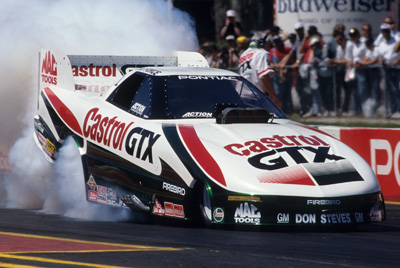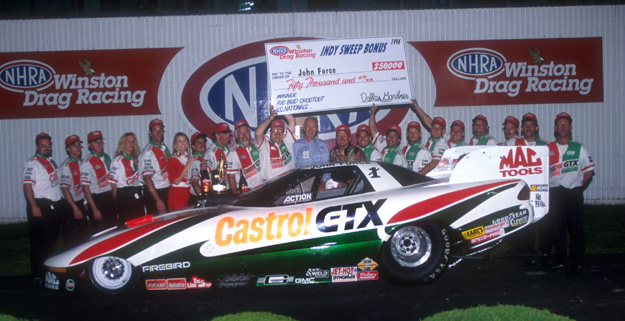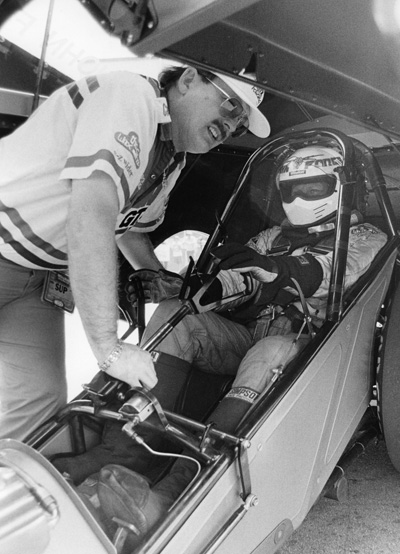

The top three: Force
 |
Continuing my review of the three cars and drivers remaining in the Top 20 Funny Cars polls, we move from Dale Pulde’s ’77 War Eagle Pontiac to John Force’s ’96 Castrol Firebird. Again, don’t read anything into me putting Pulde and Force in front of “Jungle Jim” Liberman’s ’73 Vega, but Force just happened to be at NHRA HQ in Glendora earlier this week to help sell tickets to the Auto Club NHRA Finals (you can watch the video here), so I took advantage of the situation and steered him into my office after they wrapped to get a few quick thoughts on his car being in the top three.
Force himself, of course, needs little introduction. The winningest driver in NHRA history by far with 146 victories – Frank Manzo is a distant second with 105 – and 16 world championships, he’s one of the biggest stars in the 65-year history of the sport, known to just about anyone who follows drag racing, even on a casual basis. He has built an empire and a dynasty and mentored his three daughters – Ashley, Brittany, and Courtney – into race-winning drivers as well as won championships with team drivers Robert Hight and Tony Pedregon.
The car in question was a star, too. Its performance in the 1996 season set – and 20 years later still holds – numerous single-season class records: most wins, most finals, most No.1 qualifying positions, and largest points margin over second place.
Force and crew chief Austin Coil won 13 of the season’s 19 events and were runner-up at three others. They accumulated 65 round-wins, which broke the then-record of 59 set by Pro Stock champ Darrell Alderman in 1991, and although Force’s record has been bettered three times, those were in seasons with more events, and Force’s season still reigns as the best based on a per-race round-win average. Here’s the math on the top four seasons:
| Wins | Year | Driver | Class | Events | Average |
| 76 | 2004 | Greg Anderson | Pro Stock | 23 | 3.30 |
| 76 | 2008 | Tony Schumacher | Top Fuel | 24 | 3.17 |
| 67 | 2003 | Anderson | Pro Stock | 23 | 2.91 |
| 65 | 1996 | John Force | Funny Car | 19 | 3.42 |
Alderman’s 59-round-win season (now 10th all-time) was accomplished in 18 events, giving him a 3.27 average.
During the season, Force put together three three-race winning streaks (Phoenix-Gainesville-Houston; Memphis-Topeka-Denver; and Seattle-Brainerd-Indy) and was in the season’s first seven finals, of which he won five. He not only won Indy but also doubled up by winning the Big Bud Shootout that weekend.
 |
Force also accumulated 13 No. 1 qualifying positions that season and finished 636 points ahead of the second-place driver, teammate Pedregon. The next-closest margin was Don Prudhomme’s 616-point edge over Shirl Greer to win the 1976 title.
“I get all the credit, but the truth is it was a great team, led by Austin Coil,” said Force, whose accomplishments earned him the prestigious Driver of the Year award. “I don’t know if you’ll ever see those days again when one car is that dominant. The competition now is so much tighter than it was back then.
“We had a good budget, and we were able to test every week; seems like we tested after every race,” he recalled. “And we won a lot; I hate to say it because of the way it sounds, but going to the winner’s circle, it was almost getting boring. I wish I had those days back now.”
 |
I also reached out to Coil, who was able to put the season into better perspective with the reasons behind their incredible success, and there were many beyond the braintrust that already existed with him and Bernie Fedderly calling the shots.
“For starters, at that time, under those set of NHRA rules, that body had very good aerodynamics,” he said. “A lot of our problems we had with NHRA with body rules over the next five years with the Mustang we brought out the next year were in trying to get that body as good aerodynamically as the Firebird was.
“We also had some clutch-control devices that were working real well for us and were the first to use the timing control management on the engine to help us get down the track. There were a few other guys playing with it, but it wasn't common yet.”
In a moment similar to when the cat was let out of the bag on the till-then secretive Kenny Bernstein/Dale Armstrong lock-up clutch in 1986, everyone got an earful a decade later when Force took a solo run. "Jim Brissette was standing on the starting line and turned to me and said, ‘Well, anybody who doesn’t know how to use timing does now,’ " he recalled with a laugh.
The 1996 season also was the first time that John Force Racing had a second driver in Pedregon, as well as a new crew chief for that car in the personage of creative thinker John Medlen and a bright young crewmember named Dickie Venables, who today is setting speed records left and right as tuner for Matt Hagan.
“One of the great moments of that season for us was Indy, and not just because we won the Shootout and the race,” he said. “What I really remember was Sunday, which was my birthday, and I said that all I wanted for my birthday was for our cars to be 1-2 in qualifying, and by golly, that’s how it turned out. [Force was No. 1 with a track record 4.96, Pedregon No. 2 at 4.98.]
“That, obviously, was a great season for us in terms of wins and another championship, but even more, it was what got us organized on how to run a multicar team. We had been scared to death about whether having two cars would be better or worse, but with Medlen added, we found the right mix, and then, of course, when Jimmy [Prock] came along, we found another, and it’s all part of the record books now.”
OK, two down, one to go. Next Friday, we'll take a look at our final top-three candidate, "Jungle Jim," with a look back at what made him so memorable and list-worthy, and I'll share some very interesting comments that both Force and Coil had about him.



















































